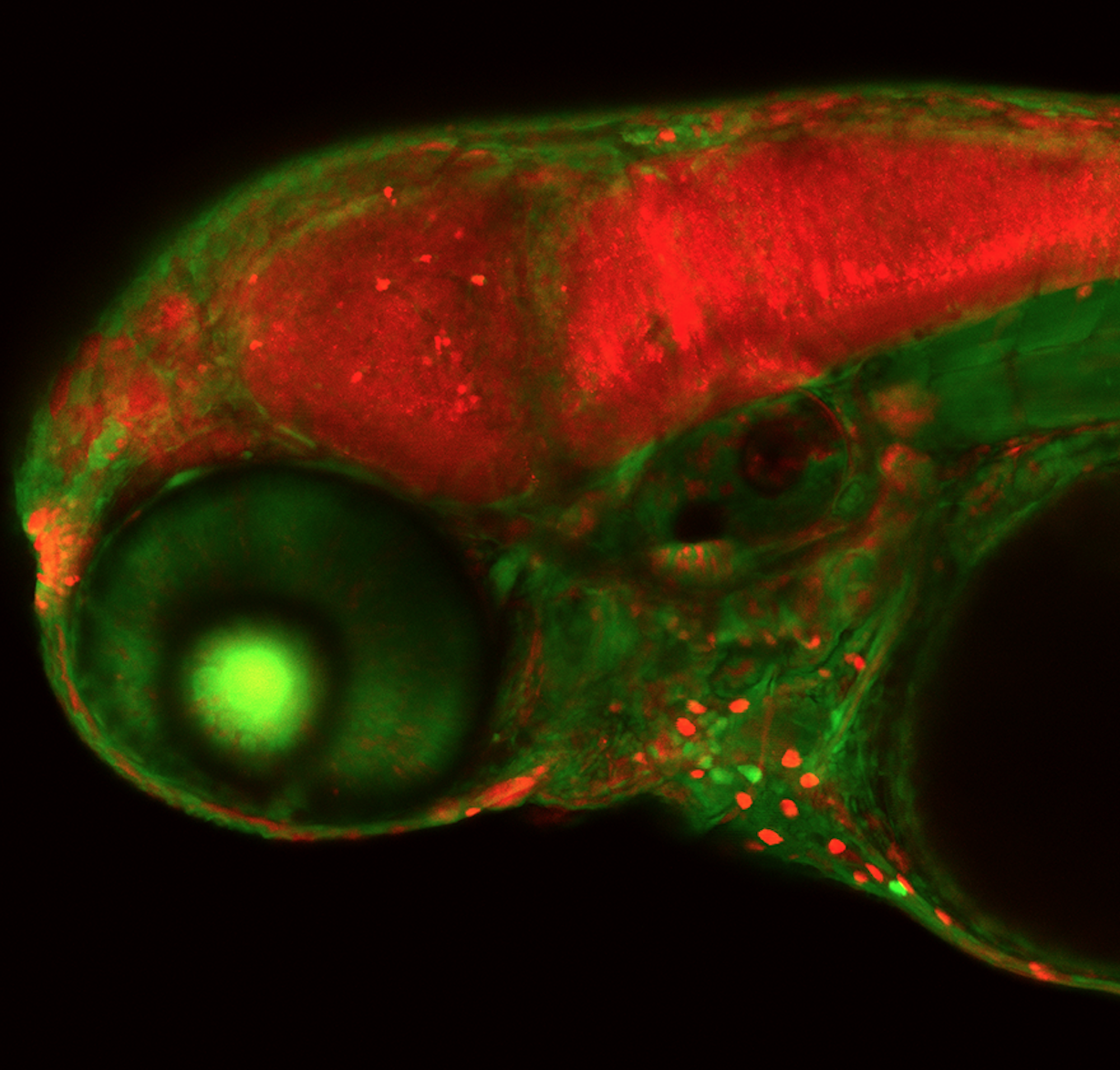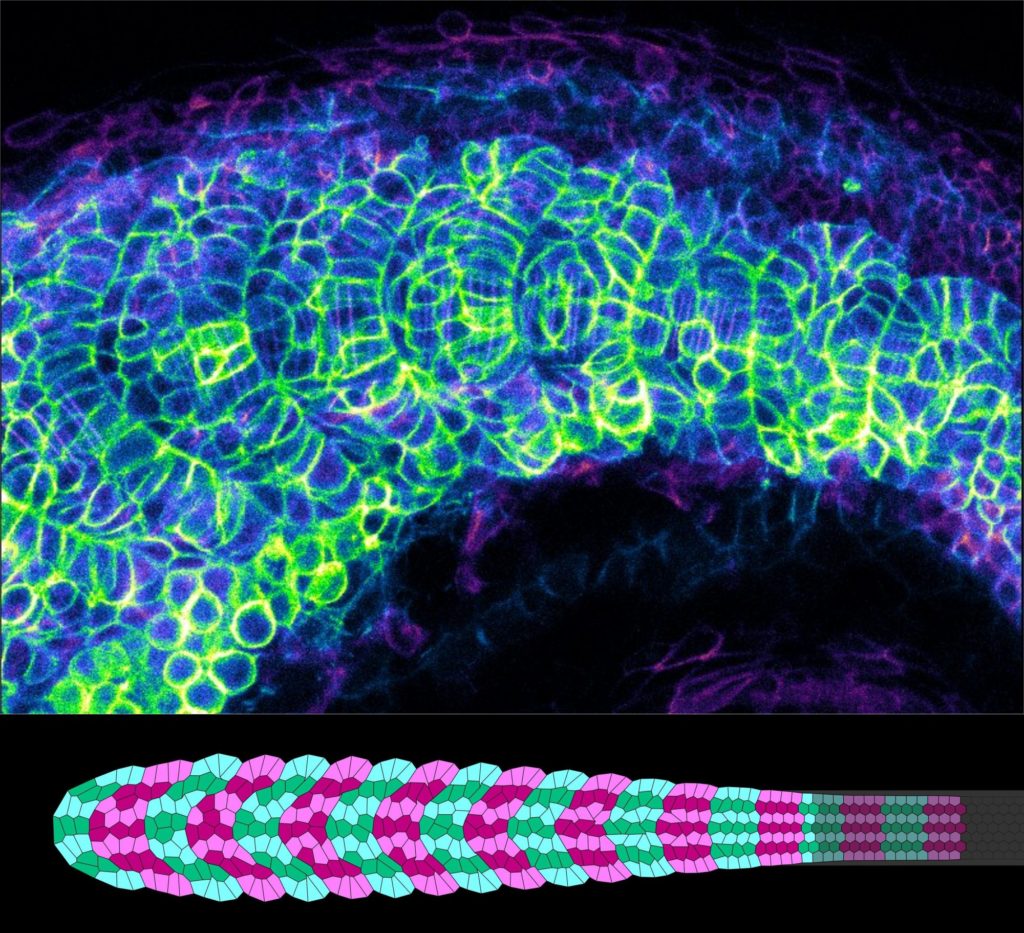Researchers discover that heart cells in developing zebrafish start beating suddenly and all at once
Tag: Zebrafish
Zebrafish model helps explain eye development
Scientists at the National Eye Institute (NEI) have developed a zebrafish model of NEDBEH—a rare genetic disorder that can cause coloboma, where parts of the eye are missing due to developmental defects. The model provides a new tool for understanding the eye’s embryonic development. The NEI is part of the National Institutes of Health.
Study finds a gut-brain link tied to social development
University of Oregon neuroscientists discovered a pathway linking microbes in the gut to those in the brain, which could lead to new treatments for neurodevelopmental conditions.
Lymphatics help ‘seed’ early brain cells in zebrafish
A recent paper in Nature Neuroscience by University of Notre Dame biologist Cody J. Smith demonstrated how lymphatics — which remove waste from the rest of the body — are also associated with microglia and brain development in zebrafish.
Calorie Count More Important than Nutrient Composition in Development of Obesity-related Kidney Disease
Article title: High-calorie diet results in reversible obesity-related glomerulopathy in adult zebrafish regardless of dietary fat Authors: Evan M. Zeitler, J. Charles Jennette, Jennifer E. Flythe, Ronald J. Falk, John S. Poulton From the authors: “This work suggests that macronutrient…
Drug-Induced Liver Injury, Prenatal Developmental Toxicity, and More Featured in September 2021 Toxicological Sciences
The September 2021 issue of Toxicological Sciences contains leading toxicological research, exploring nanotoxicology, neurotoxicology, immunotoxicology, and more.
Spontaneous Mammary Neoplasia, Cannabidiol Exposure, Aryl Hydrocarbon Receptors, and More Featured in July 2021 Toxicological Sciences
Toxicological Sciences delivers the latest toxicology research in the July 2021 issue. The issue features investigations in delivers the latest toxicology research in areas such as exposure to delta-9-tetrahydrocannabinol and cannabidiol, effects of ENDS vapors on amino acid metabolism, and more.
Cancer has ripple effect on distant tissues
A new study with zebrafish shows that a deadly form of skin cancer — melanoma — alters the metabolism of healthy tissues elsewhere in the body. The research from Washington University in St. Louis suggests that these other tissues could potentially be targeted to help treat cancer.“Tumors rely on a constant supply of nutrients to grow.
Johns Hopkins Scientists Find Mammals Share Gene Pathways That Allow Zebrafish To Grow New Eyes
Working with fish, birds and mice, Johns Hopkins Medicine researchers report new evidence that some animals’ natural capacity to regrow neurons is not missing, but is instead inactivated in mammals. Specifically, the researchers found that some genetic pathways that allow many fish and other cold-blooded animals to repair specialized eye neurons after injury remain present in mammals as well, but are turned off, blocking regeneration and healing.
Multiomics, Gentational Cd Exposure, Estrogen Receptor Transactivation, and More Featured in December 2020 Toxicological Sciences
The December 2020 issue of the Society of Toxicology’s official journal, Toxicological Sciences, delivers cutting-edge toxicological research in endocrine toxicology, environmental toxicology, organ-specific toxicology, and more.

Researchers identify process for regenerating neurons in the eye and brain
A team of researchers from the University of Notre Dame, Johns Hopkins University, Ohio State University and the University of Florida has identified networks of genes that regulate the process responsible for determining whether neurons will regenerate in certain animals, such as zebrafish.
Could a tiny fish hold the key to curing blindness?
Imagine this: A patient learns that they are losing their sight because an eye disease has damaged crucial cells in their retina. Then, under the care of their doctor, they simply grow some new retinal cells, restoring their vision.
Although science hasn’t yet delivered this happy ending, researchers are working on it – with help from the humble zebrafish. When a zebrafish loses its retinal cells, it grows new ones. This observation has encouraged scientists to try hacking the zebrafish’s innate regenerative capacity to learn how to treat human disease. That is why among the National Eye Institute’s 1,200 active research projects, nearly 80 incorporate zebrafish.

Grant will help scientists break new ground in gene editing
A new grant from the National Institutes of Health will allow Iowa State University scientists to continue to develop gene editing technologies to model human disease in zebrafish. The research aims to build new tools to determine which genes have therapeutic potential to treat human genetic diseases that affect the cardiovascular, immune and nervous systems.
Serum Biomarkers, Metabolite Indicators for Kidney Toxicity, Estrogenic Compound Screening, and More Featured in February 2020 Toxicological Sciences
The February 2020 issue of Toxicological Sciences includes cutting-edge research spanning the toxicological field, from molecular, biochemical, and systems toxicology and nanotoxicology to regulatory science, risk assessment, and decision-making.
Fighting melanoma with zebrafish: Biologists in search of a powerful combination of cancer-fighting drugs
Northern Arizona University professor Matthew Salanga is leading an 18-month project, funded by the Flinn Foundation, in search of drugs to help fight the deadliest form of skin cancer.

NUS researchers uncover how fish get their shape
A team of researchers from the Mechanobiology Institute at the National University of Singapore investigated the science behind the formation of the ‘V’ patterns – also known as chevron patterns – in the swimming muscles of fish. The study focused on the myotome (a group of muscles served by a spinal nerve root) that makes up most of the fish body. These fish muscles power the fish’s side-to-side swimming motion and the chevron pattern is thought to increase swimming efficiency. The research team found that these patterns do not simply arise from genetic instruction or biochemical pathways but actually require physical forces to correctly develop.
Cyp2F2-Mediated Lung Cancer, Rapid Risk Assessment of Color Additives, and More Featured in November 2019 Toxicological Sciences
Toxicological Sciences continues to deliver cutting-edge research in toxicology in the November 2019 issue. This issue features research on computational toxicology and databases, developmental and reproductive toxicology, and more.
Hearts and Stripes: A Tiny Fish Offers Clues to Regenerating Damaged Cardiac Tissue
Zebrafish and mammals share key cellular features; researchers have identified how the former repair their damaged hearts and now wonder if humans might someday be able to do so, too Research into the hearts of zebrafish, a pet shop staple…